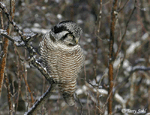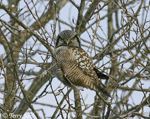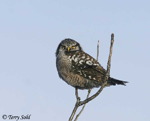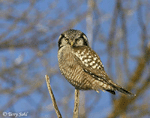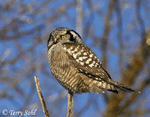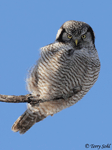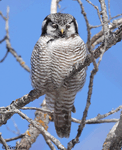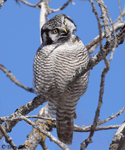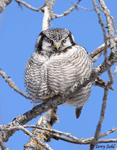| Length: 14 inches | Wingspan: 17 inches | Seasonality: Rare visitor |
| ID Keys: Long tail, strong barring underneath, black rim around face, dark upperparts with heavy white spotting. | ||
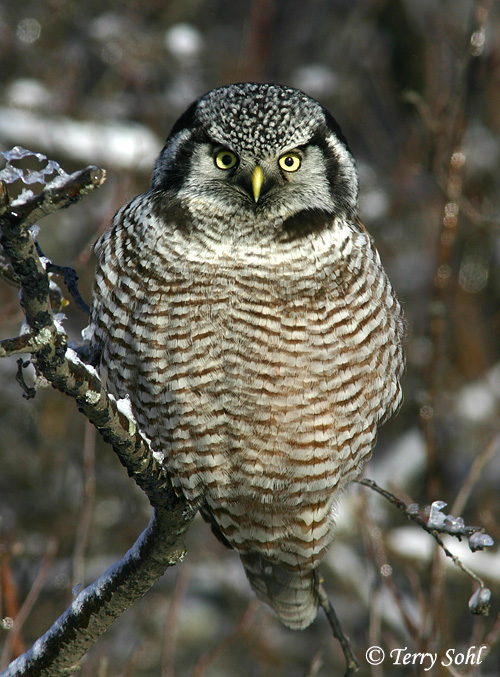 The Northern Hawk Owl is
somewhat hawk-like in both looks and behavior. They have long tails
compared to most owls, have a less "upright" posture when perched
compared to most owls, and often hunt during both the day and night. They
are less likely to wander far to the south of their normal range than are other
northern owls such as Snowy Owls and Great
Grey Owls. However, such irruptions do rarely occur, such as the
winter of 2004 and 2005, when relatively large numbers of Northern Hawk Owls
were found in northern Minnesota.
The Northern Hawk Owl is
somewhat hawk-like in both looks and behavior. They have long tails
compared to most owls, have a less "upright" posture when perched
compared to most owls, and often hunt during both the day and night. They
are less likely to wander far to the south of their normal range than are other
northern owls such as Snowy Owls and Great
Grey Owls. However, such irruptions do rarely occur, such as the
winter of 2004 and 2005, when relatively large numbers of Northern Hawk Owls
were found in northern Minnesota.
Habitat: Found in semi-open conifer and mixed conifer forests, such as forest edges and clearings, bogs, and burned areas.
Diet: Feeds mostly on rodents. Will also eat birds, large insects, frogs, lizards, and fish.
Behavior: Hunts by observing from a high perch, and swooping down in fast flight to catch prey when spotted. They are capable of hovering in flight, and may hover over suspected prey before attacking. They are also capable of catching birds in mid-air.
Breeding: The nest of a Northern Hawk Owl can be in the old nest of another bird species, in a large tree cavity, or on the top of a broken off snag. The female lays between 3 and 9 eggs, and she alone incubates them. Once the eggs hatch, the female stays with the young at first while the male feeds the family. The young fledge after about 6 weeks, but they usually stay around the parents for a few more months after fledging.
Song: 2-syllable trilling
Migration: Generally a permanent resident throughout its range, but can be nomadic as they follow rodent populations. A few may wander well to the south of their normal range in the winter.
Interactive eBird Map: Click here to access an interactive eBird map of Northern Hawk Owl sightings
Similar Species: Generally distinctive. Shape alone distinguishes them from other owls.
Conservation Status: Because most of its habitat is well removed from human activity, numbers are generally stable. The IUCN lists the Northern Hawk Owl as a species of "Least Concern".
Further Information: 1) Patuxent Bird Identification InfoCenter, Northern Hawk Owl
2) WhatBird - Northern Hawk Owl
3) Audubon Guide - Northern Hawk Owl
Photo Information: December 13th, 2004 -- Sax-Zim Bog northwest of Duluth, Minnesota -- Terry Sohl
Additional Photos: Click on the image chips or text links below for additional, higher-resolution Northern Hawk Owl photos.
| Click on the map below for a higher-resolution view |
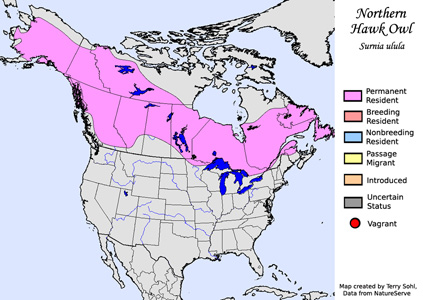 |
| South Dakota Status: Extremely rare winter visitor |
Additional Northern Hawk Owl Photos
Click for a higher-resolution version of these photos

